The Kāla Chakra
Introduction
The Sun, resplendent and glorious in his twelve forms, as the ruler of the day and the lord of the grahas, is the controller of Kāla or Time. The three navels of his amazing one-wheeled chariot are the triptych of kālas, bhūta, bhaviṣya and vartamān (past, future and present) and the different kāla sankhyās or the measurements of time like kṣaṇ, muhūrta, divasa, rātri, pakṣa, māsa, saṁvatsara, ṛtu, ayana and yugas are the different parts of his chariot. The Sun determines another three-fold division of time, sṛṣṭi, sthiti and pralaya and as Brahmā, Viṣṇu and Maheśvara, he governs the Wheel of Time or the Kāla Cakra, within whose spokes, every living being is caught. Time as governed by the Sun in the Hindu philosophical tradition, is cyclical, unlike modern mathematical time that is linear.
Without Āditya, there can be no kāla or measurement of time and without kāla there can be no order in the universe. The Sun’s basic measurement of time on earth is from sunrise to sunrise, as it traverses the complete round of the twelve rāśīs, demarcating the period into day and night, aho and rātri, as the Sun is invisible for one half of the time period. Together it is known as ahorātri, from which the word ‘Horā’ has sprung to denote the study of jyotish as Horā Śāstra. So the Sun’s movement around the dvādas rāśīs is the fundamental unit of time in the life of a living being. This is Time that is perfectly ordered and regular, and that which follows the path of Brahma. This ordered Time is known as Yama. He is dharma personified and is a son of Sūrya. Yet there is another Time, another son of the same Sūrya, that is irregular, and that does not follow dharma. It functions from midnight to midnight and heralds all that is inauspicious and malevolent. This is Mahākāla, and he is predominant in Kali Yuga, as dharma’s presence is weak during this period. Yama’s time includes destruction and death but as mere events, like the dance of Śiva which signifies pralaya and is the culmination of all creation as per nature’s law. Mahākala’s destruction is demonic and evil. If Yama is death, then Kāla is apamṛtyu.
The Kāla Cakra is mapped on to the Dik Cakra, beginning with the Sun in the East, followed by Mars, Jupiter, Mercury, Venus, Saturn, Moon and ending with Rāhu in the north eastern direction. If the Dik Cakra or the Wheel of Direction, which is manned by the ten dikpālas and lorded by Indra, depict the constructive side of life, the Kāla Cakra, the Wheel of Time, portrays the destructive events that can occur in an individual’s life. Where Dik as Direction or gati is positive, Kāla as time is negative.
Figure 1: Kāla Cakra Basics
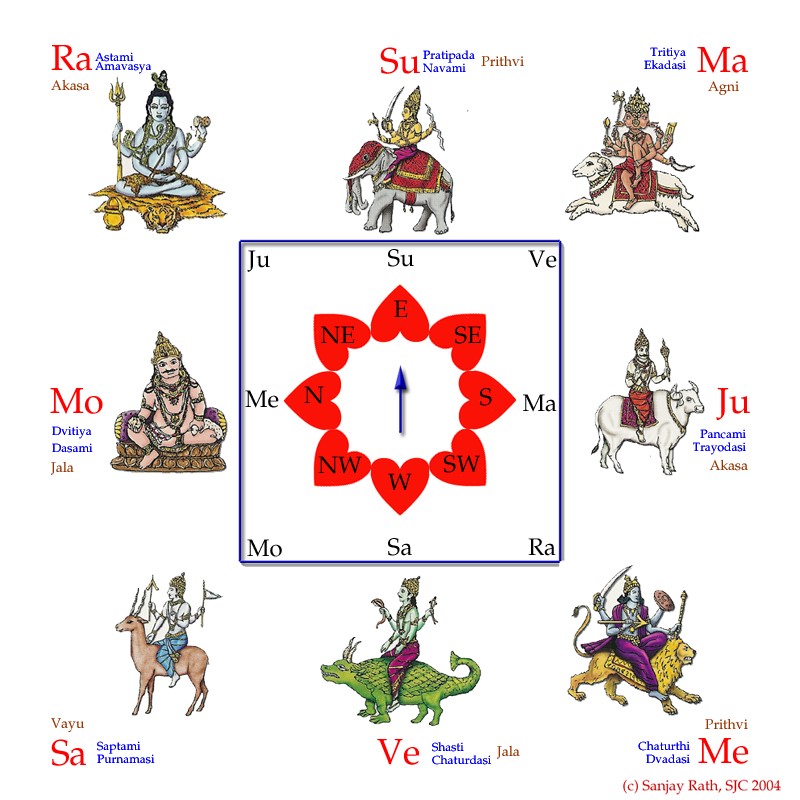
Yama was blessed by his father and became known as Dharmarāja and attained the lordship of one of the dikas as a lokapāla. Mahākāla did severe penance and attained ‘grahatva’ and became better known as Śanaiścara. Yama is the son of Sūrya from Sangyā, while Mahākāla is the son of Sangyā’s shadow self, Chāyā. Since the basic unit of regular time is the Sun’s cyclical movement across the zodiac, as depicted by Yama, the lagna, or the commencing point of the Sun’s movement is known variously as Sangyā, the point of creation. The 24 hours starting from the Sun’s movement from Sangyā are divided into 8 yamas, each spanning for 3 hours. Each half of a yama is known as a kāla, measuring 1½ hours, thereby creating 16 kālas in a day. Each kāla is ruled by a planet starting with the day lord and subsequently it follows the order of the Kāla Cakra from Sun to Rāhu. The 8 kālas which exist from sunset to sunrise begin with the 7th planet from the vāra lord in the Kāla Cakra.
Figure 2: Kāla Table
| Day: Sunrise to Sunset | |||||||
| A.M. | Sunday | Monday | Tuesday | Wednesday | Thursday | Friday | Saturday |
| 6-7:30 | Sun | Moon | Mars | Mercury | Jupiter | Venus | Saturn |
| 7:30-9 | Mars | Rāhu | Jupiter | Venus | Mercury | Saturn | Moon |
| 9-10:30 | Jupiter | Sun | Mercury | Saturn | Venus | Moon | Rāhu |
| 10:30-12 | Mercury | Mars | Venus | Moon | Saturn | Rāhu | Sun |
| 12-1:30 | Venus | Jupiter | Saturn | Rāhu | Moon | Sun | Mars |
| 1:30-3 | Saturn | Mercury | Moon | Sun | Rāhu | Mars | Jupiter |
| 3-4:30 | Moon | Venus | Rāhu | Mars | Sun | Jupiter | Mercury |
| 4:30-6 | Rāhu | Saturn | Sun | Jupiter | Mars | Mercury | Venus |
| Night: Sunset to Sunrise | |||||||
| P.M. | Sunday | Monday | Tuesday | Wednesday | Thursday | Friday | Saturday |
| 6-7:30 | Venus | Jupiter | Saturn | Rāhu | Moon | Sun | Mars |
| 7:30-9 | Saturn | Mercury | Moon | Sun | Rāhu | Mars | Jupiter |
| 9-10:30 | Moon | Venus | Rāhu | Mars | Sun | Jupiter | Mercury |
| 10:30-12 | Rāhu | Saturn | Sun | Jupiter | Mars | Mercury | Venus |
| 12-1:30 | Sun | Moon | Mars | Mercury | Jupiter | Venus | Saturn |
| 1:30-3 | Mars | Rāhu | Jupiter | Venus | Mercury | Saturn | Moon |
| 3-4:30 | Jupiter | Sun | Mercury | Saturn | Venus | Moon | Rāhu |
| 4:30-6 | Mercury | Mars | Venus | Moon | Saturn | Rāhu | Sun |
The Kāla of a planet is a period when its negativity manifests and the planet attempts to seize or grasp the native. A person having an afflicted planet ought to worship the śakti associated with that planet during its kāla. For example, there can be no better remedy for a person with an afflicted Rāhu, to worship Durgā during Rāhu Kāla. Similarly, the śaktis of the other planets are to be worshipped during the kāla of the planet representing them.
Constructing the Kāla Cakra
The Praśna Mārga in ślokas 82-84, details the construction of the Kāla Cakra. The cakra is constructed by drawing three concentric squares and then drawing four lines to connect the various points in these squares. Two lines are drawn diagonally, connecting the four corners. The other two are drawn vertically and horizontally dividing the box in four quarters. In aggregation, all four lines divide the entire box into eight triangles. The eight points on the outer periphery represent the eight directions, with the top middle point being East, followed by South East, South, South West, West, North West, North and North East, moving in a clockwise direction. Finally the 28 nakṣatras are mapped on the eight spokes, which converge at the centre of the inner square, in groups of seven. The mapping starts with Aświnī in the East on the topmost point of the outer periphery, moving down to the centre of the spoke, and then up through the diagonal spoke in the South East. In this manner the mapping ends with the 28th nakṣatra plotted in the North Eastern direction in the top left hand corner of the outer periphery.
The spokes represent the inflow and the outflow of positive and negative energies. The energies flowing from the straight lines in the Eastern, Southern, Western and Northern directions are energies which are flowing in towards the centre. These four directions represent the Kendras. The South Eastern, South Western, North Western and North Eastern corners are the Koṇas and are the points from which the energies flow out.
The Praśna Mārga states that “from the nakṣatras in the Kāla Cakra one can determine and know about the Yoginis and Mṛityu and from these other lakṣaṇas or indications can be seen”[1]. It identifies three sensitive points on the Kāla Cakra, namely, Prāṇa, Deha and Mṛtyu, from which inauspicious events and death can be predicted. This procedure is applicable for praśna; hence all horoscopy parameters employed here are that of the praśna chart.
Prāṇa: The nakṣatra of the praśna Sun is assigned to position 1 in the Kāla Cakra. Count from this position to praśna candra. This point is Prāṇa.
Deha: Assign the janma nakṣatra of the native to position 1. Count from this position to Prāṇa. This point is Deha.
Mṛtyu: Assign Kṛttikā to position 28. Count from here to the praśna candra in an anticlockwise direction. This point is Mṛtyu.
When these three points or sphutas fall in a single line or spoke of the Kāla Cakra death occurs. When Deha and Mṛtyu or when Prāṇa and Mṛtyu fall in the same line, prolonged sickness and fits occur. There is another sensitive point called Yogini. The Yogini has its own peculiar pattern of movement which is known as the dance of the Yogini. This is nothing but the dance of death and wherever the feet of the Yogini fall in the Kāla Cakra, death follows.
Figure 3: Constructing the Kāla Cakra
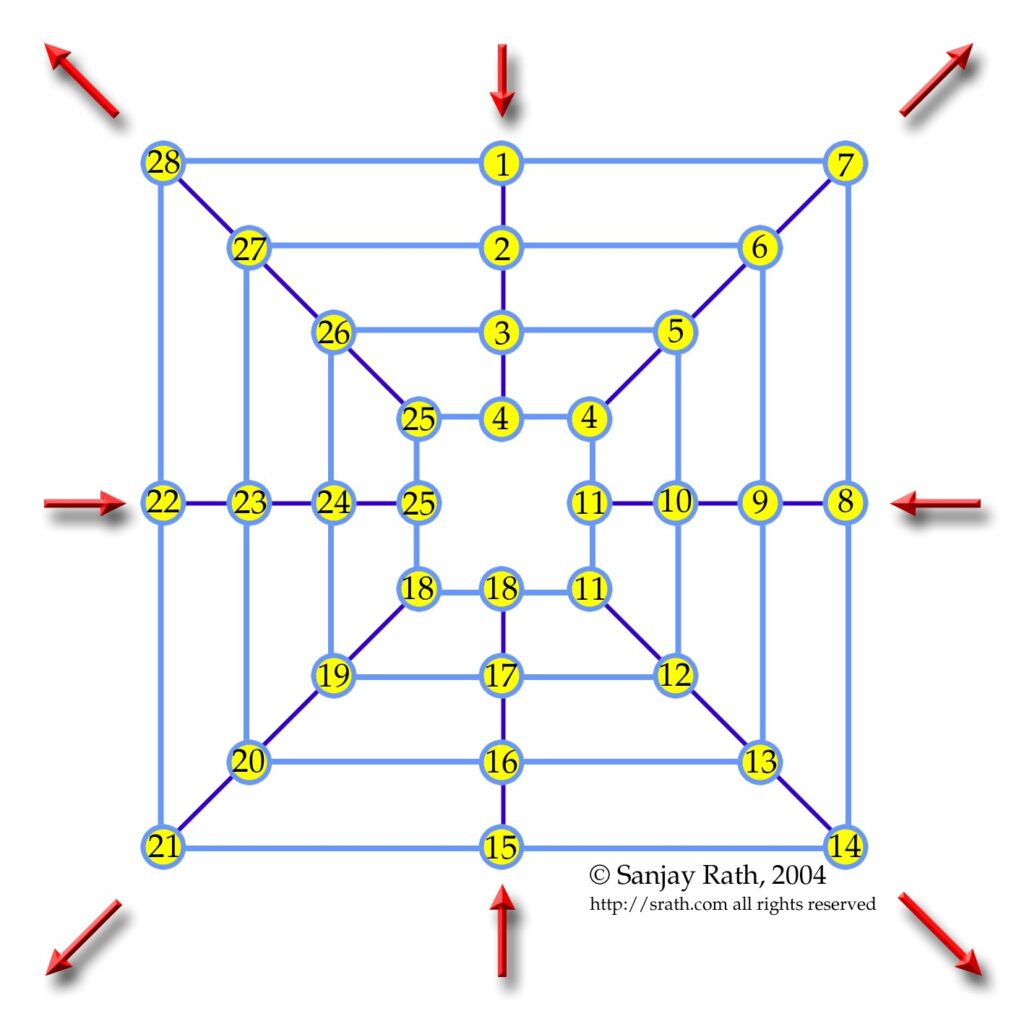
Figure 4: The Kāla Cakra – 1
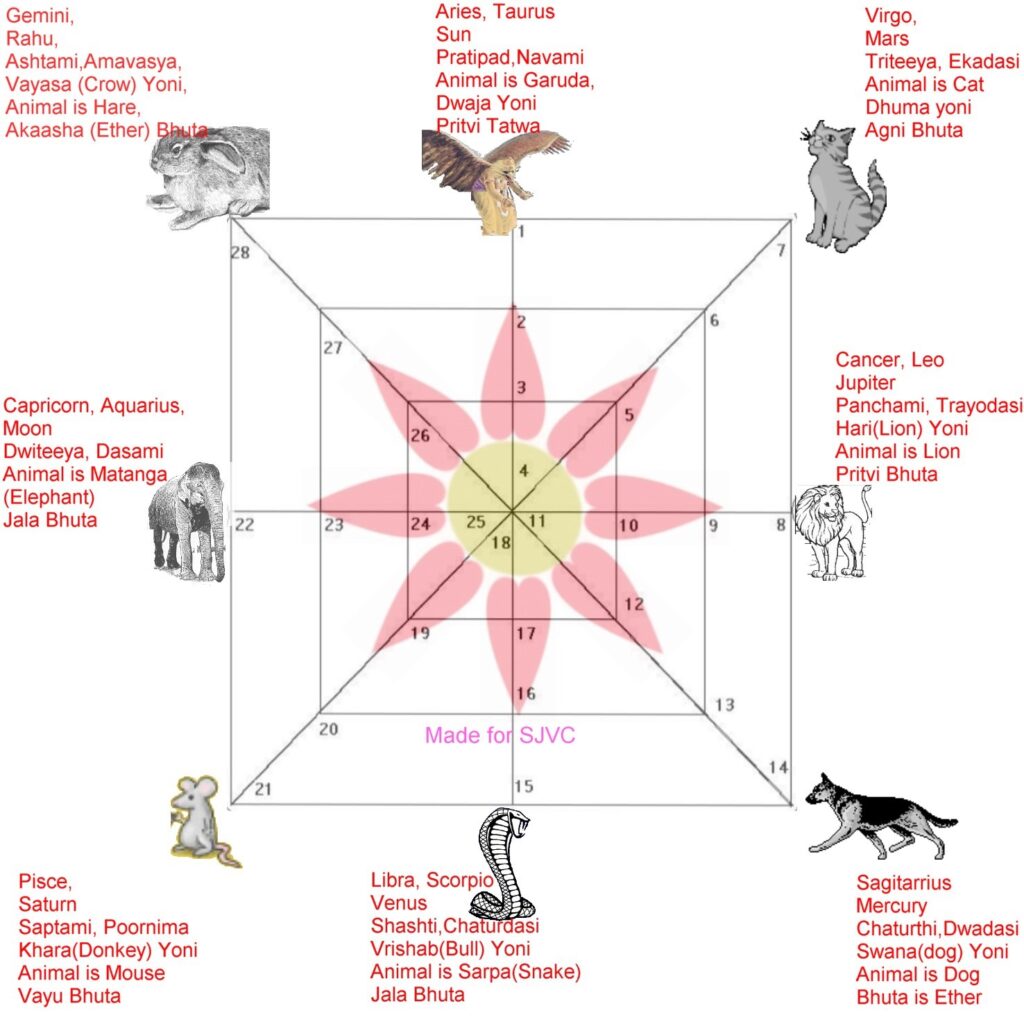
Worship and Remedies from the Kāla Cakra
The Kāla Cakra can be studied at various levels; it can be used to understand both the darker side as well as the purer side. If the Yoginis represent the darker aspects of the universe, which exist at a nether level, in the more ethereal plane the Kāla Cakra can be used for remedies for afflicted planets and for worshipping one’s iṣṭa devatā. One of the best ways to propitiate afflicted planets is to worship the deity of the planet opposite to it in the Kāla Cakra, as planets placed in opposition therein can counter each other. Mercury and Rāhu; Saturn and Mars; Sun and Venus have the ability to completely suppress the other. Hence, the deity of Mercury can be worshipped to crush an afflicted Rāhu. Deities may be worshipped at various levels: as śaktis of the planets, as forms of Viṣṇu or as the deities associated with the tithis. For example, Rāma is worshipped on Navami, Gaṇeśa on Caturthi, Sarasvatī on Pancami, Śiva on caturdasi etc.
Figure 5
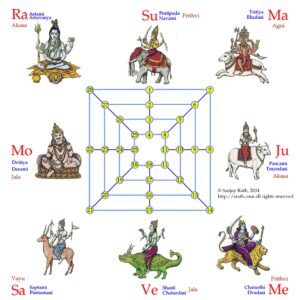
These pairs of planets in the Kāla Cakra have a peculiar symbiotic relationship. Given below is the example of Jupiter and Moon, which helps one in understanding Gajakeśarī Yoga is great depth.
Kubera and Nara Vāhana, Gaja and Kesarī in the Kāla Chakra
In the Kāla Chakra, Jupiter and Moon are posited opposite each other, in the southern and northern directions. The lord of the northern direction, where the Moon is placed, is Kubera, the god of wealth. The yoni is Nara (Man); the animal associated is Gaja (Elephant) and the deity for the direction is Durga (Umā is the pratyādhī devatā of Moon). The uniqueness of Kubera is that his vāhana is Nara, or man. This symbolizes the fact that man is enslaved by his indriyas (sensory organs) and is subject to greed for the material world, with Kubera depicting the epitome of materiality. Man is eternally in pursuit of wealth driven by his desires (Moon). The Moon represents not only the narayoni but the mind, which is forever susceptible to surrender to the dark side. The only one who can rescue man, and by corollary the mind, from this material bondage is Jupiter. Jupiter is in the southern direction in the Kāla Chakra, whose lord is Yama. The animal associated with this direction is Kesarī (Lion), represented by the Hariyoni and the deity is Indra, the pratyādhī devatā of Jupiter. The two animals associated in the concerned directions, the elephant and the lion, are the vāhanas of the deities in the opposite direction. The elephant is the vāhana of Indra and the lion is the vāhana of Durga, signifying that each can ‘ride’ the other or control the other, when the negativities of the direction become prominent.
Figure 6: The Moon & Jupiter in the Kāla Chakra
| Moon | Jupiter | |
| Direction | North | South |
| Lord | Kubera | Yama |
| Yoni | Nara | Hari |
| Animal | Gaja (Elephant) | Kesarī (Lion) |
| Deity | Durga | Indra |
| Tithis | Dvītiyā, Daśamī | Paìcamī, Trayodaśī |
Conversely, if one considers the Moon from Jupiter, then the southern direction is that of Yama, the god of the departed souls. The one who protects man from venturing towards the abode of Yama, is the deity of the northern direction, Durgā or Durgatināśinī, She who removes the evils of the way. This is beyond the scope of the paper as the discussion is about the placement of Jupiter from the Moon and not vice-a-versa.)Jupiter represents divinity in any horoscope and Hari as the lion can control the minds of a million men in a fell sweep, thereby curbing and dictating the flow of wealth (and hence greed/desires) that accrue in the hands of men. It is Hari who can lift a man from the mire of materiality and reinstate him on the spiritual path. The lion can demolish a thousand elephants as stated in the Jātaka Deśa Mārga and therefore destroy enemies. In this case the enemies are both within and without; the enemies within being the desires and distortions of the mind, as depicted by the elephant. Indra is the king (devarāja), the victorious one, the one who sits in the throne of the horoscope in the 10th house, and therefore has the power to conquer the enemy. The lion too is a king (paśurāja) and a symbol of conquest and royalty. This describes the effect of Jupiter from the Chandra kendra; when favorable, it can make a man the undisputed king of the world, untrammeled and a ruler of men, like Śrī Rāmachandra, or having conquered the senses, it can produce a perfect renunciate and a supremely spiritual person, like Śrī Achyuta Dasa (see chart below). In both cases, it is the triumph of the lion over the elephant, of the divine over the base, of Hari over man. In its ultimate form, it is a supreme condition of a very powerful Jupiter having perfect control over the dhī and the mana, and as such over the life of the native.
The Aṣṭadala Padma and the Kāla Cakra
The Kāla Cakra may be perceived at the highest level as the Aṣṭadala Padma, as the seat of the 8 Cara kārakas, where the ātmā is worshipped. Here Viṣṇu is worshipped as the Aṣṭadala Padma, wherein He dwells in the centre of the lotus, which is nothing but the hṛdaya padma. The 8 petals of the Kāla Cakra are the planets representing the 8 Cara karakas. One of these petals is stronger than the others, and that is the Ātmā Kāraka. If one of Viṣṇu’s eight names, which resonate with a particular Ātmā Kāraka, is taken repeatedly, then the soul gets cleansed.
Figure 7: The Kāla Cakra as the Aṣṭadala Padma
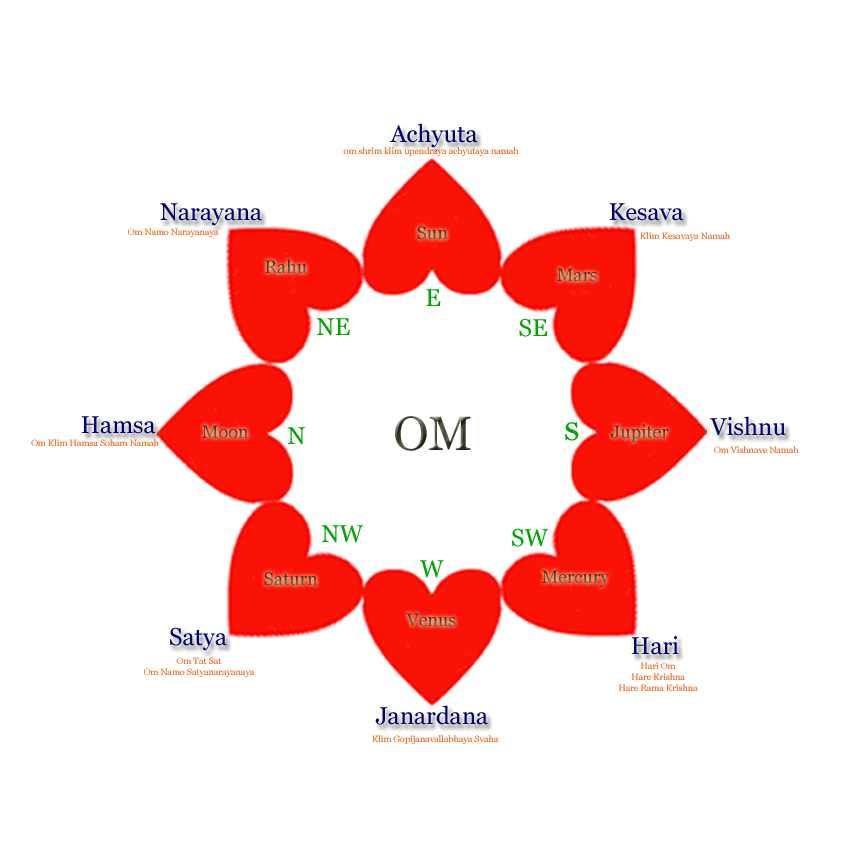
[1] Praçna Märga, Chapter 208, Çloka 81

Thank you for info..For my chart in the east j need point my sun nakshatra or ashvini ? for example j have sun in ashlesha .. 1 point in the east will be ashlesha or not ? thank you